What are Thrips?
A thrip is a winged insect that measures between 1 and 2 mm, though it can grow up to 6 mm. It belongs to the Thysanoptera family, which comprises around 5600 different species, with the most common found on cannabis plants. Frankliniella occidentalis, the most common thrip, first appeared in Almeria in 1986 from California and settled in various crops such as tomatoes. The second most common species in Spain is Thrips tabaci, which is also known as the onion thrip.
Thrips and Cannabis
Thrips won’t spoil your whole crop like other pests like budworm caterpillars, or fungus like powdery mildew. However, they can significantly reduce both the quantity and quality of your yield. Knowing how to identify and keep this pest in check is essential for good results.
How to Identify a Thrip Infestation?
- Thrips are easy to identify. If you shake your plant, you’ll see them hopping or flying from one branch to another. They can primarily be found on the tips of the stems (on the top of the plant) and on the upper leaves. They appear as small white, grey, red, yellow, or brown insects.
- Unlike other biting insects, thrips don’t secrete honeydew, which is a kind of molasses secreted by pests like the whitefly. This helps to tell them apart from other pests.
- You’ll find non-uniform white or yellowish bite marks and excrements in the form of black dots. Thrips generally bite near the edge of the leaves, unlike the red spider mite, which bites all over the leaf; or aphids and whiteflies, which prefer the leaf nerves.
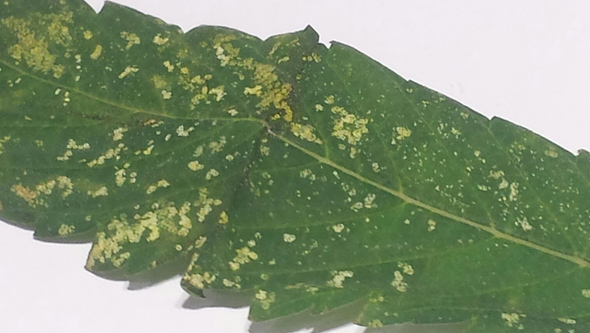
Characteristics of a Thrip Infestation
- Thrips are a common pest in outdoor crops and greenhouses, and less frequent in indoor grows (even though they may still show up and reproduce there easily). This pest often appears in spring rather than summer.
- Thrips can reproduce sexually or through parthenogenesis, meaning they can reproduce without needing a male sex cell. An unfertilized female produces only females through parthenogenesis. In contrast, a female fertilized by a male produces both males and females.
- A female thrip can lay between 30 and 300 eggs depending on the species, temperature, and humidity levels (the lower the humidity, the fewer the viable eggs). Therefore, you must ensure you have good ventilation and extraction in your grow room. Read our post on ventilation in indoor cannabis grows for more information on this subject.
Thrip Life Cycle
In outdoor cannabis crops, thrips usually start appearing in spring. They develop when the temperature is above 15°C and below 36°C. In indoor grows, given that the temperature needs to remain stable between 20 and 25°C, you must be vigilant all year round.
Thrips go through the following life stages: egg (3-5 days), two larval stages (approx. 8 days), pupa (pre-nymph and nymph; 4-5 days), and adult (20-75 days).
Different Stages of the Life Cycle of Thrips
- Egg: Adult female thrips lay tiny yellowish eggs which measure between 150 and 250 microns. They insert these eggs into the plant tissue. The eggs take 3 to 5 days to hatch.
- Larva: A thrip in its larval stage is pearl grey, and becomes more ochre as it develops. It takes roughly 8 days to reach the pupa stage. There are two larval stages, during which thrips actively feed by biting the leaves.
- Pupa: During the pupal stage, thrips usually move to the substrate and go through two stages (pre-nymph and nymph). While they are in the soil in their pupal stage, thrips don’t feed, and complete this stage in 4/5 days.
- Adult: Adult thrips return to the crops to feed, reproduce, and lay eggs. A male can live between 30 and 50 days, and a female between 40 and 75 days. The less common species Thrips tabaci lives around 20-25 days and lays fewer eggs.
Damage Caused to Cannabis Plants by Thrips
- Thrips in larval state absorb sap, weakening the plant. If the plant is in the growth phase, it’ll stop growing or become less vigorous. If it is flowering, the process will be delayed and the volume of buds reduced. Thrips also cause negative stress, which also decreases growth and flowering.
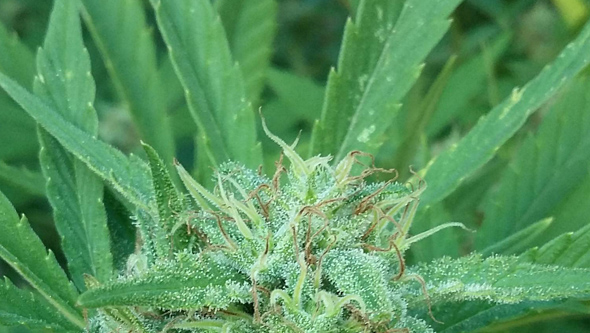
- By biting the leaves, thrips can transmit viruses and infections that can harm cannabis plants or reduce their yield.
How to Prevent Thrips on Your Cannabis Plants
It’s always better to prevent pests than to have to eliminate them, and thrips are no exception. Here are some tips to help you prevent the attack of these insects:
- Avoid nitrogen excess (typically caused by excessive use of growth fertiliser or highly fertilised substrates), as this attracts thrips and other pests like whiteflies.
- Encourage the presence of natural enemies. Don’t use insecticides that are toxic to thrip predators.
- Place blue adhesive traps in your grow. These are very effective in preventing the arrival of adult thrips and in identifying the type of pest.
- You can also use other preventative measures like Cannacure or Leaf Coat, which work by creating a film on the surface of the leaves. Not only does this make it more difficult for the infestation to take hold but also helps enhance the plant’s resistance to stress.
- Control the sanitary conditions of the crop. For indoor grows, avoid entering your grow room wearing street clothes to prevent the introduction of pests.
- Periodically examine your plants, especially the surface of the leaves. Look for eggs, bite marks, etc.
- If you’re using home compost or adding manure to your grow, make sure they’ve properly fermented and are pest-free.
- Silicate and Urtimax contain silicon, which reinforces the epidermis, making it thicker and more resistant to pests. Similarly, Diatical (which is made of diatomaceous earth) destroys the insects’ exoskeleton and is an essential product in the prevention of thrips.
-
- You can also use Prot-Eco Bio Neem or Trabe Pronem Biological Insecticide as prevention methods to stop thrips from infesting your crop (the latter is recommended for extensive cannabis cultivation). These products of biological origin are made from Neem Oil and are highly effective in preventing sucking insects like thrips, as well as preventing the onset of fungi. Neem oil is extracted from the seeds of a tree and is not harmful to other beneficial insects for cannabis cultivation, such as bees or ladybugs. It can be used through foliar application with a dose of 1 to 2 ml per liter of water, or added to irrigation water at the recommended manufacturer’s dose. Despite being a product of biological origin, its use should be stopped 15 days before harvest.
How to eliminate thrips from cannabis plants during the growth phase
If you’ve identified a thrip infestation in your grow, you should fight it promptly to prevent it from spreading. This way, you’ll ensure that neither the yield nor the quality of your cannabis are affected.
There’s a wide range of products that will help you to efficiently eliminate thrips during the growth phase. As plants aren’t yet flowering at this stage, you can choose between biological or chemical insecticides.
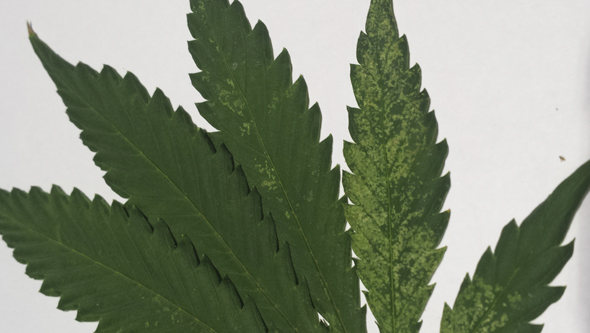
Fighting thrips during the growth stage with biological insecticides
- If the pest has already settled in the cannabis plant during the vegetative phase, we recommend spraying it with pyrethrum or organic pyrethrins such as Spruzit, which also contains rapeseed oil that suffocates the eggs of thrips. In addition, you can combine this treatment with a Neem oil spray for maximum efficacy.
- It is very useful to combine insecticides with products that stimulate natural defenses and that also perform anti-stress functions, assisting plants to recover more quickly. Bac Plant Vitality Plus and Cinaprot by Proteco are good examples of this. Strengthening the plants minimizes the action of the toxins that thrips inject when they bite the leaves.
Fighting thrips during the growth stage with chemical insecticides
- If you have an indoor grow and have recently suffered from an infestation of thrips or other insects like whiteflies or mites (such as red spider mites or micro mites), you can eradicate them completely before starting your next grow using Solfac Automatic Forte, which is an automatic insecticide spray.
How to eliminate thrips from cannabis plants during the flowering stage
During the flowering phase, you can only use biological insecticides, because chemical insecticides remain in the plant for a long time, which could be harmful to the health of those who later use the flowers. Keep in mind that you can also use natural predators to end a thrip infestation during both the vegetative and flowering cycles.
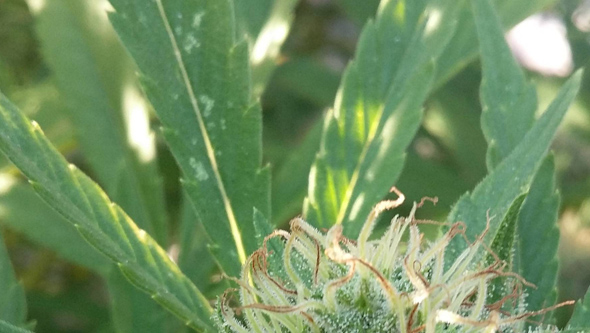
How to fight thrips during the flowering stage with biological insecticides
The flowering stage is the least convenient time for an infestation to develop. Hence, it’s really important to insist on treatments, in addition to doing it correctly.
- To combat thrips, you can use effective biological insecticides like Spruzit, with ovicidal action, and alternate them with a potassium soap like Mobet.
- Inspect the plants every day. Look at the undersides of the leaves, where you’ll find the eggs and larvae, and remove them with a cotton swab moistened in any of the previously mentioned products.
- Keep in mind that reducing the humidity to 40% indoors drastically decreases the fertility of thrip eggs.
Fighting thrips with natural predators
Thrips have several natural enemies that are very effective in reducing infestations:
- Amblyseius cucumeris, a mite commonly found in Europe that feeds on hatched eggs and larvae. Also useful against red spider mites.
- Orius laevigatus, a Mediterranean bug that also attacks aphids.
- Amblyseius swirskii, a predatory mite of whitefly and thrip eggs and larvae found in the Mediterranean.
- Macrolophus caliginosus, a common bug in Spain, predator of flies and thrips. It feeds on larvae and adults.
Bear in mind that incorporating natural enemies in balconies and outdoor cannabis grows can be complicated, so it’s always better to promote the presence of local insects, which are already adapted to the local environment.
Talk to our team if you need advice on natural predators for any type of pest.
General advice
- Thrips aren’t fatal to cannabis plants: they’re easy to prevent, identify, and eliminate, but it’s very important not to procrastinate once you find them, as they spread rapidly.
- Always keep your grow clean, and change your clothes and shoes before entering the indoor grow area.
- La Huerta Grow Shop recommends reading the labels and leaflets of the insecticides and preventive products carefully and attentively. Respect the product’s indications and safety deadlines.
- If you have any questions, please talk to us. At La Huerta Grow Shop, we are committed to protecting cannabis plants in a biological and natural way, whilst always respecting the environment.
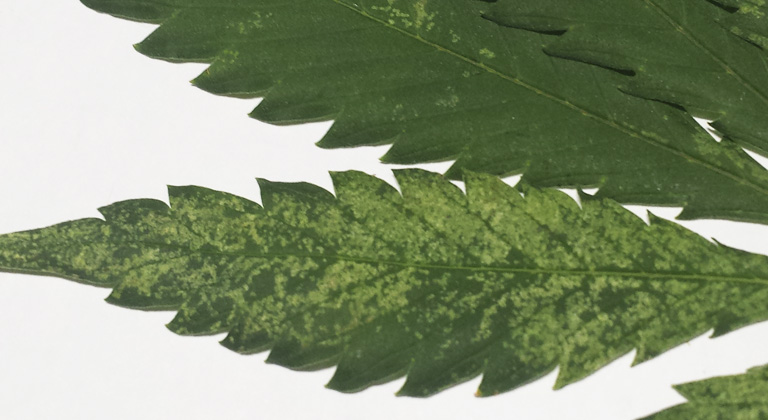


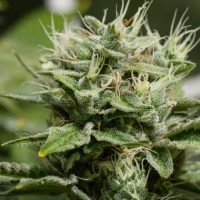
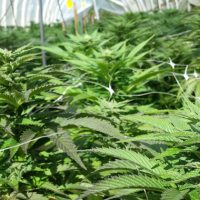


2 responses
Hello, my name is Temple and I am co-founder of Temple Wake Farms, located in Fort Pierce, FL. First, I would just like to sincerely thank you for your website. We have found it extremely informative and useful on many occasions. We have a commercial grow in an outdoor greenhouse. Recently, we have noticed some distinctive signs of various mites, including red spider mites, thrips, and a possible fusarium outbreak. We have used many biological/ organic preventative methods, such as lady bugs, praying mantises, bio nickel, yucca extract, neem oil, Triact 70, etc. but are extremely interested in any more methods available. I was just curious, considering this harvest will be one of our smaller yields, if there are any samples that you might be able to provide for us as trials against any pests/fungus in the greenhouse. Any assistance will be greatly appreciated. Thank you in advance, Sincerely, Temple Wake Farms.
Temple Wake Farms
5603 S Indian River Dr.
Fort Pierce, FL
34982
Hello,
Depending on the problem and environment, we would recommend different techniques. Pyrethrins, whether synthetic or organic, are your best allies for persistent pests like mites during flowering. In the growth phase and in temperate areas, the use of sulfur is effective for managing mites and fungi such as powdery mildew or botrytis. Diatomaceous earth is also effective on contact against pests resistant to the neurotoxic effects of insecticides.
For soil-borne fungi like fusarium, prevention is key in my opinion. Living soils rich in microorganisms help keep these pathogens at bay, from pH control to the creation of antibiotics by these beneficial organisms. *Bacillus subtilis* and *Trichoderma harzianum* are the most well-known, but there are many species and subspecies that can be helpful. It’s always advisable to conduct soil studies beforehand to understand what type of soil you have and how to improve it.
Best regards, and congratulations on the legalization!